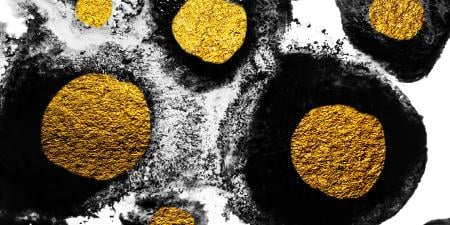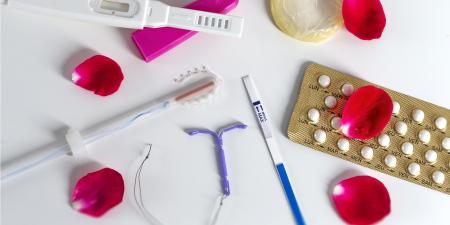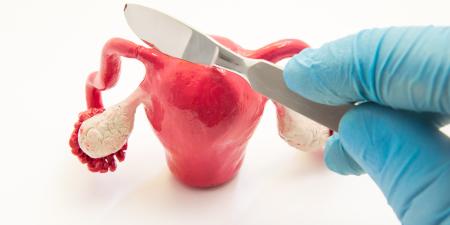Introduction
Throughout the world, including the United States, one-half of all pregnancies are unplanned, leading to unsafe abortions and the unnecessary deaths of thousands of healthy young women [1, 2]. While reversible contraceptive options for women have proliferated to include pills, patches, injections, intrauterine devices, and permanent sterilization [3], no new reversible contraceptive options have arisen for men since the development of condoms over 400 years ago. Despite expressions of interest in a reversible hormonal contraceptive for men by men and women of multiple races, religions, and ethnicities [4, 5], there is still no commercially available option. This article will review the theory, the current agents in development, and the potential risks and benefits of a reversible male hormonal contraceptive.
Physiology of Male Hormonal Contraception
The theory behind a reversible male hormonal contraceptive involves manipulation of the hypothalamic-pituitary-gonadal axis that regulates testicular steroidogenesis and spermatogenesis. In men with proper gonadal function (eugonadal men), pulsatile release of gonadotropin-releasing hormone stimulates the release of luteinizing hormone and follicle-stimulating hormone from the pituitary gland. Luteinizing hormone binds to Leydig cells to stimulate testosterone production, while follicle-stimulating hormone stimulates Sertoli cells to produce sperm [6]. Testosterone diffuses into the blood stream and serves to regulate its own production by providing negative feedback at the level of the hypothalamus and pituitary gland. In healthy, eugonadal men, this system of dual-hormonal control with luteinizing hormone and follicle-stimulating hormone allows for the production of nearly 1,000 sperm per second [7].
Male hormonal contraceptives capitalize on the neuroendocrine negative feedback loop by providing exogenous testosterone, which suppresses production of gonadotropin-releasing hormone, luteinizing hormone, and follicle-stimulating hormone, thereby blocking endogenous testosterone production in the testes and, subsequently, spermatogenesis. Cessation of male hormonal contraceptive regimens leads to universal return of normal testicular function including spermatogenesis [8, 9].
Sperm concentrations in healthy men exceed 14 million per ml of ejaculate produced [10]. Complete absence of sperm in the ejaculate, called “azoospermia,” makes fertilization of ova impossible. Therefore the goal of a male hormonal contraceptive is to induce azoospermia in those men undergoing treatment. However, a sperm concentration of less than1 million per ml of ejaculate, called “severe oligozoospermia,” has been associated with a risk of pregnancy of approximately 1 percent per year [11]. A goal of severe oligozoospermia has been defined as a reasonable goal for contraceptive development and regulatory approval, inasmuch as this would confer an efficacy similar to that of hormonal contraceptives for women [12, 13].
Testosterone-Based Regimens
While sperm concentration goals define “success” in most studies evaluating contraceptive regimens, “efficacy” is defined by pregnancy rates. The majority of studies evaluating contraceptive efficacy have used protocols containing only testosterone. The World Health Organization (WHO) conducted the first contraceptive efficacy trial using testosterone enanthate, 200 mg administered intramuscularly weekly. While sperm concentrations declined below 1 million per ml in 98 percent of subjects, 11 pregnancies occurred, accounting for an overall efficacy rate of only 94.7 percent [11]. More recent studies using testosterone undecanoate (TU), a long-acting testosterone formulation 500 mg of which is given intramuscularly each month, showed similarly high rates of spermatogenesis suppression; 95-97 percent of subjects achieved less than1 million sperm per ml, and the efficacy rates were 94.2-96.7 percent [14, 15]. In addition, contraceptive options using testosterone alone have shown wide variation based on ethnicity when looking at suppression of spermatogenesis [16].
Addition of a progestin agent to testosterone-containing regimens has been shown to increase rates of suppression of spermatogenesis among all ethnic groups [8]. Several long-acting progestin agents have been used in combination with TU with very promising results. Etonogestrel, initially designed as a long-acting implantable contraceptive for women, shows a 94 percent rate of suppression of spermatogenesis to less than 1 million per ml when used with TU in an international randomized controlled trial [17]. Similarly, norethistrone enanthate, a long-acting injectable progestin, showed great promise when combined with TU in a small trial of 40 men [18]. The WHO sponsored a large international contraceptive trial enrolling 400 couples to further explore this combined regimen for hormonal contraceptive efficacy in men. The WHO recently stopped this trial early due to concern that the risk of side effects from the regimen may outweigh the potential contraceptive benefits to the study participants [19].
Transdermal testosterone gels provide more consistent, stable serum testosterone concentrations than some injectable forms of testosterone [20]. While only 90 percent effective at suppressing sperm concentrations to less than 1 million per ml when used in combination with injectable medroxyprogesterone acetate [21], a gel formulation appears to be quite acceptable to men and may provide a reasonable contraceptive option in the future [22]. Testosterone gel has also been used in combination with nestorone gel, a progesterone derivative, to create a completely topical form of male hormonal contraception. Shown to be highly effective at gonadotropin suppression [23], the combination of testosterone gel and nestorone gel are currently being tested in a 6-month randomized, multicenter contraceptive study looking at suppression of spermatogenesis as the primary outcome.
Alternative Androgens for Hormonal Contraception
Testosterone-based male hormonal contraceptive regimens have not yet achieved a consistent enough level of efficacy in all subjects to allow drug development to progress to widespread use. In addition, the majority of likely testosterone-based regimens require the addition of a progestin agent to improve rates of suppression of spermatogenesis. In an attempt to circumvent the need for a multidrug contraceptive regimen, alternative synthetic androgens have been developed for possible use as contraceptive options.
Dimethandrolone undecanoate (DMAU) is a potent synthetic androgen with activity at both the androgen and progesterone receptors, and can be administered both orally and by injection [24]. While studies in humans have not yet been done, early studies of DMAU in rabbits have been promising. A 60-day study showed suppression of gonadotropins and severe oligozoospermia in all rabbits receiving 2.5 mg per kg per day [25]. In addition, mating trials showed that all oligozoospermic rabbits receiving DMAU were rendered infertile, and all recovered to normal levels of spermatogenesis within 18 weeks of stopping DMAU. Studies testing this promising compound in humans are in the planning stages and will, it is hoped, begin soon.
Another synthetic androgen, 7-alpha-methyl-19-nortestosterone (MENT), is significantly more potent than testosterone and can be administered annually as a subdermal implant [26]. MENT is resistant to 5-alpha-reduction, both contributing to its high potency at the androgen receptor and also helping to prevent possible risk to prostate health by avoiding increased exposure to dihydrotestosterone (DHT) [27]. Initially studied for 4 weeks to assess safety in healthy, eugonadal men [28], and for 6 weeks as treatment for hypogonadal men [29], a small dose-finding study looking at MENT as a single-agent contraceptive for men was extremely promising. Eighty-two percent of men in the highest dose group achieved azoospermia during the study, and 100 percent of men in this group became oligozoospermic (defined as less than 3 million per ml) during the study [26]. Given these promising results, a larger randomized controlled trial looking at MENT for male hormonal contraception should begin in 2012.
Risks and Benefits of Male Hormonal Contraception
While it is hard to accurately predict the true risks and benefits of long-term hormonal contraception for men when no FDA-approved contraceptive option exists, the potential risks and benefits of a contraceptive regimen can be inferred from our knowledge of long-term hormonal replacement in men and from contraceptive trials. Aside from the benefits of improved contraceptive efficacy, testosterone therapy in hypogonadal men significantly increases lean body mass and decreases fat mass [30] and affects healthy men on a testosterone-only contraceptive regimen similarly [31]. The beneficial effects on body composition appear to be partially attenuated by the addition of a progestin agent, levonorgestrel (LNG). In a randomized trial comparing testosterone enanthate to testosterone plus LNG, subjects receiving LNG still showed an increase in lean body mass, but also had an increase in abdominal fat mass, as compared to a decrease seen in the testosterone-only group [32]. Testosterone therapy in hypogonadal men significantly increases bone mineral density for up to 16 years [33]. When administered as a single-agent contraceptive to healthy young men, testosterone enanthate also increases bone mineral density [31], but long-term effects in healthy men, and the effects of a contraceptive regimen when a progestin agent is added, remain unknown.
Evaluating the risks of a male hormonal contraceptive regimen can often be challenging, both because of the limited duration of studies and the lack of a control group in most studies. In addition, the range of common side effects varies dramatically and may be reflective of the progestin agent used. In the largest male hormonal contraceptive study, using testosterone undecanoate injections monthly for 30 months in more than 1,000 men, 7 percent reported an increase in acne and less than 1 percent reported mood changes or skin irritation [15]. Alternatively, in a trial comparing a testosterone-and-etonogestrel contraception regimen to placebo, rates in the treatment group were significantly higher than in the placebo group for acne (26 percent versus 10 percent), increase in body weight (24 percent versus 10 percent), change in libido (13 percent versus 0), and night sweats (27 percent versus 8 percent), but rates of mood changes (19 percent versus 10 percent) were similar in both groups [17]. Testis volume is known to decrease by about 4-5 ml when testosterone is used for contraception due to the effect of gonadotropin suppression on seminiferous tubule volume and Leydig cell volume [15]. Given that all men on contraceptive regimens recover their sperm output after discontinuing the contraceptive regimen (the exact timing depends on the drug and the individual), the testis volume is also expected to return to baseline [8]. Erythrocytosis, also a known side effect of testosterone therapy in hypogonadal men, appears to be dose-related and to affect men differently based on age, and it has not been a frequent adverse event reported in contraceptive trials [34].
The potential impact of male hormonal contraceptive regimens on metabolism and cardiovascular risk are of concern when considering long-term treatment of otherwise healthy men. The overall impact of testosterone on lipids when used for hypogonadism therapy appears to be a small decrease in high-density lipoprotein [35], but the clinical significance of this alteration is unclear. Conflicting data reports both higher rates of cardiovascular mortality in men with low serum testosterone [36], and significantly higher rates of cardiovascular events in men treated with testosterone therapy [37]. The implications of this information gathered in a population of men that is not likely to use long-term contraceptive therapy are difficult to apply to young, eugonadal men and highlight the need for additional studies of the cardiovascular implications of contraceptive therapy.
Similarly, the potential risk of contraceptive therapy to prostate growth and prostate cancer remains undefined. A large meta-analysis of testosterone therapy for up to 3 years showed no increase in adverse prostate outcomes [35], yet the potential impact of a contraceptive regimen on prostate health over a longer period of time has not been studied.
Conclusions
The development of a reversible male hormonal contraceptive would offer a monumental improvement in reproductive choices for both men and women. While many options have been tested, no pharmaceutical company has applied to the Food and Drug Administration for permission to bring any of those regimens to market. The development of new, synthetic androgens offering the potential for a single-agent contraceptive regimen are promising, but further research including larger phase III trials and more exploration of potential long-term risks needs to be pursued.
References
- Sedgh G, Henshaw S, Singh S, Ahman E, Shah IH. Induced abortion: estimated rates and trends worldwide. Lancet. 2007;370(9595):1338-1345.
- Henshaw SK, Singh S, Haas T. The incidence of abortion worldwide. Int Fam Plann Persp. 1999;25(Suppl):S30-S38.
- Blumenthal PD, Edelman A. Hormonal contraception. Obstet Gynecol. 2008;112(3):670-684.
-
Glasier AF, Anakwe R, Everington D, et al. Would women trust their partners to use a male pill? Hum Reprod. 2000;15(3):646-649.
- Martin CW, Anderson RA, Cheng L, et al. Potential impact of hormonal male contraception: cross-cultural implications for development of novel preparations. Hum Reprod. 2000;15(3):637-645.
- Hall PF. On the stimulation of testicular steroidogenesis in the rabbit by interstitial cell-stimulating hormone. Endocrinology. 1966;78(4):690-698.
- Amann RP, Howards SS. Daily spermatozoal production and epididymal spermatozoal reserves of the human male. J Urol. 1980;124(2):211-215.
- Liu PY, Swerdloff RS, Christenson PD, Handelsman DJ, Wang C. Rate, extent, and modifiers of spermatogenic recovery after hormonal male contraception: an integrated analysis. Lancet. 2006;367(9520):1412-1420.
- Ly LP, Liu PY, Handelsman DJ. Rates of suppression and recovery of human sperm output in testosterone-based hormonal contraceptive regimens. Hum Reprod. 2005;20(6):1733-1740.
- Cooper TG, Noonan E, von Eckardstein S, et al. World Health Organization reference values for human semen characteristics. Hum Reprod Update. 2010;16(3):231-245.
-
Contraceptive efficacy of testosterone-induced azoospermia and oligozoospermia in normal men. Fertil Steril. 1996;65(4):821-829.
-
Nieschlag E. 10th Summit Meeting consensus: recommendations for regulatory approval for hormonal male contraception. October 22-23, 2006. Contraception. 2007;75(3):166-167.
- Moreau C, Trussell J, Rodriguez G, Bajos N, Bouyer J. Contraceptive failure rates in France: results from a population-based survey. Hum Reprod. 2007;22(9):2422-2427.
- Gu YQ, Wang XH, Xu D, et al. A multicenter contraceptive efficacy study of injectable testosterone undecanoate in healthy Chinese men. J Clin Endocrinol Metab. 2003;88(2):562-568.
- Gu Y, Liang X, Wu W, et al. Multicenter contraceptive efficacy trial of injectable testosterone undecanoate in Chinese men. J Clin Endocrinol Metab. 2009;94(6):1910-1915.
-
Ilani N, Liu PY, Swerdloff RS, Wang C. Does ethnicity matter in male hormonal contraceptive efficacy? Asian J Androl. 2011;13(4):579-584.
- Mommers E, Kersemaekers WM, Elliesen J, et al. Male hormonal contraception: a double-blind, placebo-controlled study. J Clin Endocrinol Metab. 2008;93(7):2572-2580.
- Qoubaitary A, Meriggiola C, Ng CM, et al. Pharmacokinetics of testosterone undecanoate injected alone or in combination with norethisterone enanthate in healthy men. J Androl. 2006;27(6):853-867.
-
Male hormonal contraceptive trial ending early [news release]. Arlington, VA: CONRAD; April 22, 2011. http://www.conrad.org/news-pressreleases-63.html. Accessed January 11, 2012.
- Steidle C, Schwartz S, Jacoby K, Sebree T, Smith T, Bachand R. AA2500 testosterone gel normalizes androgen levels in aging males with improvements in body composition and sexual function. J Clin Endocrinol Metab. 2003;88(6):2673-2681.
- Page ST, Amory JK, Anawalt BD, et al. Testosterone gel combined with depomedroxyprogesterone acetate is an effective male hormonal contraceptive regimen and is not enhanced by the addition of a GnRH antagonist. J Clin Endocrinol Metab. 2006;91(11):4374-4380.
- Amory JK, Page ST, Anawalt BD, Matsumoto AM, Bremner WJ. Acceptability of a combination testosterone gel and depomedroxyprogesterone acetate male contraceptive regimen. Contraception. 2007;75(3):218-223.
- Mahabadi V, Amory JK, Swerdloff RS, et al. Combined transdermal testosterone gel and the progestin nestorone suppresses serum gonadotropins in men. J Clin Endocrinol Metab. 2009;94(7):2313-2320.
- Attardi BJ, Hild SA, Reel JR. Dimethandrolone undecanoate: a new potent orally active androgen with progestational activity. Endocrinology. 2006;147(6):3016-3026.
- Attardi BJ, Enbring JA, Gropp D, Hild SA. Development of dimethandrolone 17beta-undecanoate (DMAU) as an oral male hormonal contraceptive: induction of infertility and recovery of fertility in adult male rabbits. J Androl. 2011;32(5):530-540.
- von Eckardstein S, Noe G, Brache V, et al. A clinic trial of 7-alpha-methyl-19-nortestosterone implants for possible use as a long-acting contraceptive for men. J Clin Endocrinol Metab. 2003;88(11):5232-5239.
- Kumar N, Didolkar AK, Monder C, Bardin CW, Sundaram K. The biological activity of 7-alpha-methyl-19-nortestosterone is not amplified in male reproductive tract as is that of testosterone. Endocrinology. 1992;130(6):3677-3683.
- Noe G, Suvisaari J, Martin C, et al. Gonadotrophin and testosterone suppression by 7alpha-methyl-19-nortestosterone acetate administered by subdermal implant to healthy men. Hum Reprod. 1999;14(9):2200-2206.
- Anderson RA, Martin CW, Kung AW, et al. 7alpha-methyl-19-nortestosterone maintains sexual behavior and mood in hypogonadal men. J Clin Endocrinol Metab. 1999;84(10):3556-3562.
- Wang C, Cunningham G, Dobs A, et al. Long-term testosterone gel (AndroGel) treatment maintains beneficial effects on sexual function and mood, lean and fat mass, and bone mineral density in hypogonadal men. J Clin Endocrinol Metab. 2004;89(5):2085-2098.
- Young NR, Baker HW, Liu G, Seeman E. Body composition and muscle strength in healthy men receiving testosterone enanthate for contraception. J Clin Endocrinol Metab. 1993;77(4):1028-1032.
- Herbst KL, Anawalt BD, Amory JK, Matsumoto AM, Bremner WJ. The male contraceptive regimen of testosterone and levonorgestrel significantly increases lean mass in healthy young men in 4 weeks, but attenuates a decrease in fat mass induced by testosterone alone. J Clin Endocrinol Metab. 2003;88(3):1167-1173.
- Behre HM, Kliesch S, Leifke E, Link TM, Nieschlag E. Longterm effect of testosterone therapy on bone mineral density in hypogonadal men. J Clin Endocrinol Metab. 1997;82(8):2396-2390.
- Coviello AD, Kaplan B, Lakshman KM, Chen T, Singh AB, Bhasin S. Effects of graded doses of testosterone on erythropoiesis in healthy young and older men. J Clin Endocrinol Metab. 2008;93(3):914-919.
- Fernandez-Balsells MM, Murad MH, Lane M, et al. Clinical review 1: Adverse effects of testosterone therapy in adult men: a systematic review and meta-analysis. J Clin Endocrinol Metab. 2010;95(6):2560-2575.
- Basaria S, Coviello AD, Travison TG, et al. Adverse events associated with testosterone administration. N Engl J Med. 2010;363(2):109-122.
- Malkin CJ, Pugh PJ, Morris PD, Asif S, Jones TH, Channer KS. Low serum testosterone and increased mortality in men with coronary heart disease. Heart. 2010;96(22):1821-1825.



